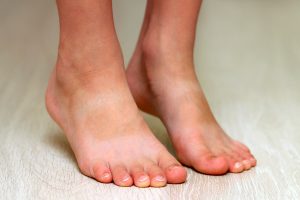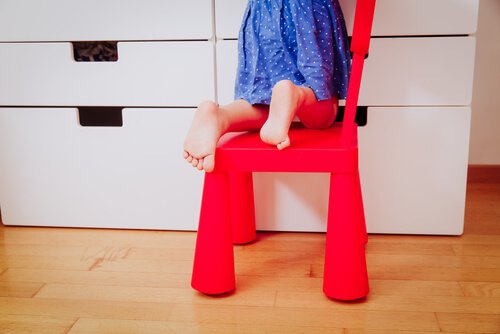Flat Feet in Children: What Is It and How Can It Be Avoided?

There’s no specific measurement to determine the “normal” height that a foot’s arch should have. In fact, one fifth of the population doesn’t develop a clear arch when standing.
If a person doesn’t experience pain, and if an arch appears when the person stands tip-toed, this is considered normal. This condition is called “flexible flat feet.” It doesn’t require treatment as long as the child doesn’t experience pain or discomfort.
Rigid flat feet
In this case, flat feet is considered pathological. The condition is uncommon and consists of an abnormal fusion of the bones in the feet, causing malformations.
Rigid flat feet always give off a flattened appearance, no matter the position or movement. The arch never appears, no matter what. When a person has rigid flat feet, this can be quite painful.
Rigid flat feet is a complex condition and can even cause misalignment of a child’s posture. Doctors diagnose the condition with the help of X-ray technology.
Therapies for this type of flat feet include both physical therapy as well as insoles to reduce the pain. In the most extreme cases, medical professionals will recommend a surgical intervention.
Flat feet is small children
Before the ages of 3 or 4 years old, children place their entire foot on the ground when standing. At this stage of development, flat feet is actually a normal condition, because the arch in their foot hasn’t formed yet.

When a child begins to stand and walk on his own, then it’s possible for a doctor to make a diagnosis. This is the stage of childhood when little ones begin to explore the world with their feet. This takes place through walking, running, jumping, climbing, etc.
During this stage, the muscles in the area become stronger. At the same time, the adipose tissue on the sole of the child’s foot diminishes and the arch begins to form. By the time a child is 5 years old, the arch is visible, and will continue to become more recognizable over time.
Symptoms of flat feet in children
In most cases, flat feet is not a painful condition. Below is a list of the symptoms that point to the most severe cases of flat feet:
- The arches of your child’s feet present malformations.
- Your child falls when running, etc, because his or her knees knock together.
- Your child walks in a peculiar way.
- When your child walks or exercises for a prolonged period of time, he or she complains of weakness or pain.
- Cramping.
- Pain in the heels, lower legs or knees.
“Before the ages of 3 or 4 years old, children place their entire foot on the ground when standing. At this stage of development, flat feet is a normal condition”
How can flat feet be corrected?
By instructing your child to carry out the following exercises, you can help him or her avoid flat feet. Each of these simple activities will help strengthen the muscles in your little one’s feet:
- Walk first on tip toes and then with the heels.
- Place both feet together, and then raise and lower the heels.
- Walk barefoot on uneven surfaces like sand, carpet, rocks, etc.
- Make circles in the air with the toes.
- Pick up objects – pencils, balls, etc – with tips of feet.

Recommendations for parents
To prevent this alteration from becoming established over time, physical therapists recommend the following:
- Keep your child’s weight under control and avoid childhood obesity.
- Establish a routine of simple exercises to do at home. Try to make this activity fun so that your child is consistent and doesn’t get bored.
- Allow your child to walk around barefoot on different surfaces.
- Be extra careful when it comes to choosing your child’s shoes.
As for this last point, it’s important that your child’s shoes meet the requirements that specialists recommend:
- Shoes should be comfortable, flexible and lightweight, allowing your child’s feet to move freely.
- Your child’s shoes should mold easily to his or her feet.
- The material that makes up the shoes should be breathable, in order to prevent fungus.
- Shoes should protect your child’s feet from sprains and injury.
Although flat feet isn’t a serious condition, it’s something that you can and should avoid. With the implementation of simple activities like those we mentioned above, parents can prevent, for the most part, the appearance of flat feet.
There’s no specific measurement to determine the “normal” height that a foot’s arch should have. In fact, one fifth of the population doesn’t develop a clear arch when standing.
If a person doesn’t experience pain, and if an arch appears when the person stands tip-toed, this is considered normal. This condition is called “flexible flat feet.” It doesn’t require treatment as long as the child doesn’t experience pain or discomfort.
Rigid flat feet
In this case, flat feet is considered pathological. The condition is uncommon and consists of an abnormal fusion of the bones in the feet, causing malformations.
Rigid flat feet always give off a flattened appearance, no matter the position or movement. The arch never appears, no matter what. When a person has rigid flat feet, this can be quite painful.
Rigid flat feet is a complex condition and can even cause misalignment of a child’s posture. Doctors diagnose the condition with the help of X-ray technology.
Therapies for this type of flat feet include both physical therapy as well as insoles to reduce the pain. In the most extreme cases, medical professionals will recommend a surgical intervention.
Flat feet is small children
Before the ages of 3 or 4 years old, children place their entire foot on the ground when standing. At this stage of development, flat feet is actually a normal condition, because the arch in their foot hasn’t formed yet.

When a child begins to stand and walk on his own, then it’s possible for a doctor to make a diagnosis. This is the stage of childhood when little ones begin to explore the world with their feet. This takes place through walking, running, jumping, climbing, etc.
During this stage, the muscles in the area become stronger. At the same time, the adipose tissue on the sole of the child’s foot diminishes and the arch begins to form. By the time a child is 5 years old, the arch is visible, and will continue to become more recognizable over time.
Symptoms of flat feet in children
In most cases, flat feet is not a painful condition. Below is a list of the symptoms that point to the most severe cases of flat feet:
- The arches of your child’s feet present malformations.
- Your child falls when running, etc, because his or her knees knock together.
- Your child walks in a peculiar way.
- When your child walks or exercises for a prolonged period of time, he or she complains of weakness or pain.
- Cramping.
- Pain in the heels, lower legs or knees.
“Before the ages of 3 or 4 years old, children place their entire foot on the ground when standing. At this stage of development, flat feet is a normal condition”
How can flat feet be corrected?
By instructing your child to carry out the following exercises, you can help him or her avoid flat feet. Each of these simple activities will help strengthen the muscles in your little one’s feet:
- Walk first on tip toes and then with the heels.
- Place both feet together, and then raise and lower the heels.
- Walk barefoot on uneven surfaces like sand, carpet, rocks, etc.
- Make circles in the air with the toes.
- Pick up objects – pencils, balls, etc – with tips of feet.

Recommendations for parents
To prevent this alteration from becoming established over time, physical therapists recommend the following:
- Keep your child’s weight under control and avoid childhood obesity.
- Establish a routine of simple exercises to do at home. Try to make this activity fun so that your child is consistent and doesn’t get bored.
- Allow your child to walk around barefoot on different surfaces.
- Be extra careful when it comes to choosing your child’s shoes.
As for this last point, it’s important that your child’s shoes meet the requirements that specialists recommend:
- Shoes should be comfortable, flexible and lightweight, allowing your child’s feet to move freely.
- Your child’s shoes should mold easily to his or her feet.
- The material that makes up the shoes should be breathable, in order to prevent fungus.
- Shoes should protect your child’s feet from sprains and injury.
Although flat feet isn’t a serious condition, it’s something that you can and should avoid. With the implementation of simple activities like those we mentioned above, parents can prevent, for the most part, the appearance of flat feet.
This text is provided for informational purposes only and does not replace consultation with a professional. If in doubt, consult your specialist.








